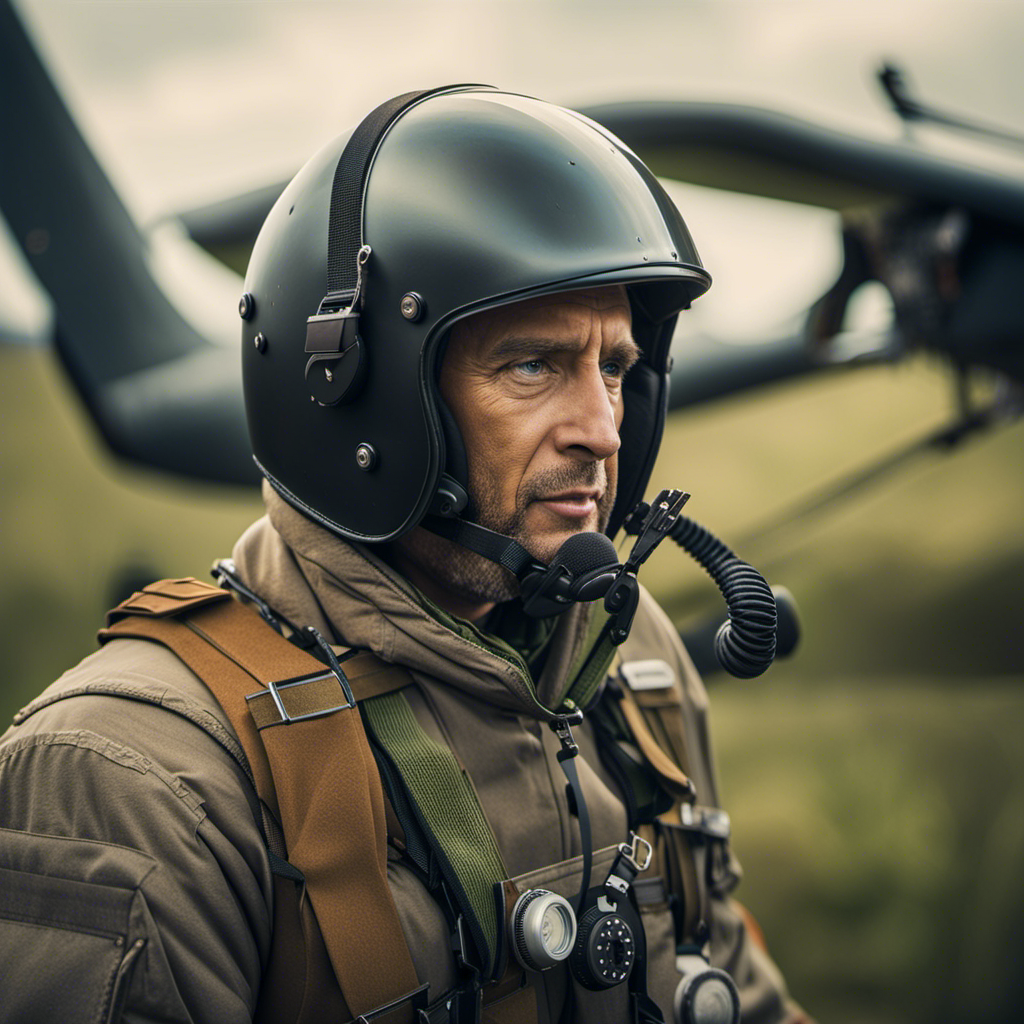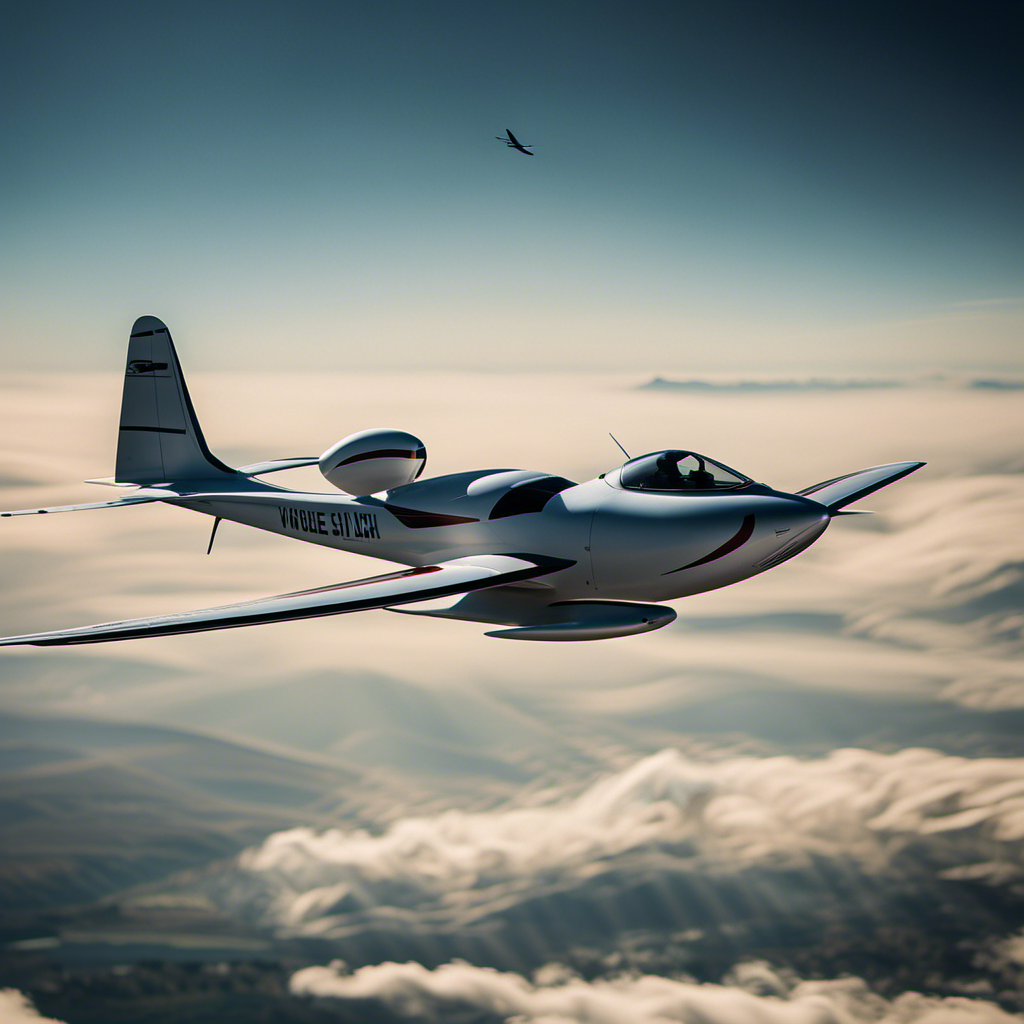As a seasoned glider pilot, I am well-acquainted with the excitement and feeling of freedom that comes from soaring through the skies. However, prioritizing safety is crucial to ensure a smooth flying experience.
Imagine this scenario: you’re gliding effortlessly, only to encounter unexpected turbulence. With proper knowledge and preparation, you can navigate these challenges and make your flight safer.
In this comprehensive guide, I will share essential tips and procedures that will help you enhance your glider safety and enjoy every moment in the air.
Key Takeaways
- Regularly inspect and maintain glider equipment and instruments for proper working condition
- Familiarize yourself with emergency procedures and ensure all emergency equipment is in working condition and easily accessible
- Stay updated on weather conditions and interpret cloud formations for weather changes
- Maintain situational awareness by continuously scanning for other aircraft and staying updated on airspace restrictions and regulations
Pre-Flight Checklist
Before taking off, it’s important to go through a pre-flight checklist to ensure a safe flight. Preflight preparation is an essential step in glider safety measures. By meticulously going through this checklist, you can identify any potential issues and address them before they become a problem during the flight.
The pre-flight checklist includes various tasks that need to be completed. First, inspect the glider’s equipment and instruments to ensure they are in proper working condition. Check the control surfaces, such as the ailerons and elevator, to ensure they move freely and without any obstruction. Additionally, inspect the canopy and ensure it closes securely. It’s crucial to check the parachute system and ensure it is properly packed and ready for use.
Next, check the glider’s weight and balance. Ensure that it is within the recommended limits to maintain proper stability during the flight. It’s important to adjust the ballast if necessary to achieve the optimal weight distribution.
Inspect the Glider’s Equipment and Instruments
Check if all the equipment and instruments are in proper working condition before taking off. Glider equipment maintenance is crucial to ensure a safe and enjoyable flight experience. It is important to regularly inspect and maintain the equipment to prevent any potential issues that may arise during flight. Additionally, instrument calibration and accuracy play a vital role in the safety of the flight. By ensuring that all instruments are properly calibrated and accurate, you can rely on them for precise measurements and readings throughout the flight.
To help you keep track of the equipment and instruments that need to be inspected, here is a table outlining the key components and their maintenance requirements:
| Equipment/Instrument | Maintenance Required |
|---|---|
| Wings and control surfaces | Check for any damage or loose parts |
| Landing gear | Inspect for wear and tear |
| Cockpit instruments | Calibrate and check for accuracy |
| Safety harness | Ensure proper functioning |
| Emergency equipment | Verify availability and condition |
By regularly inspecting and maintaining these components, you can ensure that your glider is in optimal condition for flight.
As you complete the equipment and instrument inspection, it is important to familiarize yourself with emergency procedures. This will enable you to respond quickly and effectively in case of any unforeseen circumstances.
Familiarize Yourself with Emergency Procedures
Once you’ve completed the equipment and instrument inspection, it’s important to familiarize yourself with emergency procedures. Safety is paramount when it comes to gliding, and being prepared for any unforeseen circumstances is crucial.
In the event of an emergency landing, knowing what to do and having the necessary skills can make all the difference.
Firstly, familiarize yourself with the emergency equipment on board. This includes items such as fire extinguishers, first aid kits, and emergency parachutes. Understand how to use each of these in case of an emergency. Additionally, ensure that all emergency equipment is in proper working condition and easily accessible.
Next, familiarize yourself with the emergency procedures specific to your glider. This may include actions to take in the event of a loss of control, an engine failure, or an emergency landing. Study and practice these procedures until they become second nature. Remember, being prepared can help you stay calm and make sound decisions in a high-pressure situation.
Understanding weather conditions and their impact on gliding is the next crucial step in ensuring your safety. Weather plays a significant role in the success and safety of your flight. It’s important to know how different weather conditions can affect your glider’s performance and plan your flight accordingly.
Understand Weather Conditions and their Impact on Gliding
Understanding weather conditions is crucial for safe gliding. Different weather conditions can significantly impact the performance of your glider. As a glider pilot, it is essential to have a good understanding of meteorology and take appropriate safety precautions.
Here are five key points to consider when it comes to weather conditions and gliding:
-
Thermals: Understanding how thermals form and behave is vital for glider pilots. Thermals are columns of rising air that can provide lift for the glider. Knowing how to identify and utilize thermals can greatly enhance the glider’s performance.
-
Wind: Wind direction and speed can greatly affect the glider’s flight. It is important to be aware of the wind conditions at different altitudes and understand how they can impact the glider’s trajectory and handling.
-
Clouds: Cloud formations can provide valuable information about the atmospheric conditions. Learning how to interpret cloud types and patterns can help pilots anticipate changes in weather and make informed decisions during the flight.
-
Fronts and pressure systems: Understanding the movement and characteristics of fronts and pressure systems can help glider pilots predict changes in weather conditions and avoid potentially hazardous situations.
-
Weather forecasting: Keeping up-to-date with accurate weather forecasts is essential for safe gliding. Utilizing reliable sources and understanding the terminology used in weather reports can help pilots plan their flights accordingly.
By having a solid understanding of meteorology and taking necessary safety precautions, glider pilots can ensure a safer and more enjoyable flying experience.
Now, let’s discuss how to properly secure yourself in the cockpit without compromising your comfort and mobility.
Properly Secure Yourself in the Cockpit
To ensure your comfort and mobility in the cockpit, it’s important to securely fasten your seatbelt and adjust the harness straps accordingly. Cockpit restraints are a vital safety feature that can protect you in the event of turbulence or sudden maneuvers.
When adjusting your seat, make sure it is positioned in a way that provides optimal visibility and access to controls. The seat should be firmly locked into place, ensuring stability during flight. Adjusting the harness straps is equally important. The straps should fit snugly but not restrict your movement or breathing. It’s crucial to find the right balance between comfort and security.
Once you have fastened your seatbelt and adjusted the harness straps, you can focus on the flight ahead. However, it’s essential to maintain communication with ground control throughout the journey. This will ensure that you receive important updates on weather conditions, airspace restrictions, and any other pertinent information.
Maintain Communication with Ground Control
Make sure you stay in constant communication with ground control to receive important updates and ensure a safe and informed gliding journey. Communication protocols are vital in any aviation activity, and gliding is no exception. Before takeoff, establish clear communication channels with ground control and ensure that you have a reliable means of contact throughout your flight. This will allow you to receive important updates on weather conditions, airspace restrictions, and any other relevant information that may affect your flight.
In addition to regular communication, it is crucial to establish emergency communication procedures. This includes having a designated emergency frequency or channel that you can switch to in case of an unexpected situation or loss of contact with ground control. Familiarize yourself with emergency communication protocols and practice using them during training flights to ensure that you are prepared for any unforeseen circumstances.
By staying vigilant and aware of your surroundings, you can enhance the safety of your gliding experience. This means constantly monitoring your surroundings, including other aircraft, airspace restrictions, and weather conditions. Maintaining situational awareness will allow you to make informed decisions and take appropriate actions to avoid potential hazards.
As you glide through the skies, remember that effective communication is key to a safe and successful flight. Stay connected with ground control, establish emergency communication procedures, and remain vigilant of your surroundings. These practices will help ensure that your gliding journey is both enjoyable and safe.
Stay Vigilant and Aware of Your Surroundings
By staying aware and observant of your surroundings, you can ensure a safer gliding journey. Gliding is a thrilling experience, but it requires constant vigilance to maintain safety. Here are some key points to keep in mind:
-
Maintain situational awareness: Always be aware of the current weather conditions, including wind speed and direction. Keep an eye out for any potential hazards such as other aircraft, birds, or obstacles on the ground.
-
Conduct a thorough pre-flight inspection: Before taking off, thoroughly inspect your glider for any signs of damage or malfunction. Pay close attention to the control surfaces, cables, and instruments.
-
Monitor your altitude and speed: Regularly check your altitude and speed to ensure you are within safe limits. Be mindful of any sudden changes in altitude or speed, as this could indicate a problem with your glider.
By following these guidelines and staying alert, you can enhance your awareness and situational analysis during your gliding journey. This will greatly contribute to your safety and the overall enjoyment of your flight.
Transition: Now that we have discussed the importance of staying vigilant and aware of your surroundings, let’s move on to the next section: following safe takeoff and landing procedures.
Follow Safe Takeoff and Landing Procedures
Ensure a smooth takeoff and landing by properly following the designated procedures and maintaining control of the glider at all times. Takeoff techniques are crucial for a successful flight. Before taking off, it is essential to check the wind direction and speed. Align the glider with the wind, ensuring that the wings are level and the nose is pointed into the wind. Apply steady and progressive pressure on the controls to lift the glider off the ground smoothly. Once in the air, maintain a safe climb speed, and avoid sudden control inputs to prevent stalling or losing control.
Landing strategies are equally important for a safe flight. As you approach the landing area, ensure that you have proper speed and altitude. Reduce the speed gradually by gently applying back pressure on the controls. Keep an eye on the airspeed indicator to avoid stalling. Maintain a constant descent rate and aim to touch down smoothly on the designated landing spot.
Transitioning into the next section about staying updated on glider safety regulations, it is crucial to understand that following the proper takeoff and landing procedures is just one aspect of ensuring a safe flight. To enhance your flight experience and maintain safety, it is essential to stay updated on glider safety regulations and guidelines. By staying informed about any changes or updates in safety protocols, you can further enhance your skills and knowledge, making your flight experience even safer.
Stay Updated on Glider Safety Regulations
After ensuring safe takeoff and landing procedures, it is essential to stay updated on glider safety regulations to further enhance the safety of your flight experience. Glider safety regulations can change over time, so it is crucial to remain informed and knowledgeable about any updates or changes that may affect your gliding activities. Here are four key reasons why staying updated on glider safety regulations is important:
-
Compliance: By staying updated on glider safety regulations, you can ensure that you are in compliance with the latest guidelines and requirements set by aviation authorities. This helps you avoid any potential penalties or legal issues.
-
Enhanced Safety: Glider safety regulations are designed to enhance the safety of gliding operations. By staying updated, you can implement the necessary safety measures and procedures to minimize risks and accidents during your flights.
-
Maintenance Guidelines: Glider safety regulations often include guidelines for glider maintenance. Staying updated on these regulations enables you to properly maintain your glider, ensuring that it is in optimal condition and reducing the chances of mechanical failures during flight.
-
Community Awareness: By staying updated on glider safety regulations, you contribute to creating a culture of safety within the gliding community. Sharing your knowledge and experiences with others helps raise awareness and promote safe practices among fellow glider pilots.
Transition: Now that we understand the importance of staying updated on glider safety regulations and maintenance, let’s delve into the next crucial aspect of ensuring a safe flight experience: continuous training and education.
Continuous Training and Education
To maximize my skills and knowledge in gliding, it’s important for me to actively engage in continuous training and education. Gliding is an exhilarating sport that requires ongoing learning and improvement to ensure safety and proficiency. By staying updated with the latest techniques and best practices, I can constantly refine my abilities and enhance my overall gliding experience.
Continuous improvement is vital in gliding, as it allows me to adapt to new challenges and advance my skills. By participating in regular training sessions, I can learn from experienced instructors who can provide guidance and feedback. These sessions can cover a range of topics, including navigation techniques, emergency procedures, and advanced maneuvers. Each training session builds upon the previous one, helping me to steadily progress as a glider pilot.
In addition to formal training, it’s crucial to stay updated on the latest developments and advancements in gliding. This can be achieved through attending workshops, seminars, and conferences, where experts in the field share their knowledge and insights. By staying informed, I can stay ahead of any changes in regulations or safety practices, ensuring that I am always operating within the guidelines.
Continuous training and education are essential for any glider pilot who wants to excel in this sport. By actively seeking opportunities to learn and improve, I can enhance my skills, stay updated on best practices, and ultimately make my flight experiences safer and more enjoyable.
Frequently Asked Questions
What are the common mistakes pilots make during takeoff and landing procedures?
Common mistakes during takeoff and landing procedures include failing to follow safety regulations, not properly calculating wind conditions, and poor communication with the ground crew. These errors can compromise the safety of the flight.
How often should glider pilots undergo training and education to stay up-to-date with safety regulations?
As a glider pilot, it’s crucial to stay updated with safety regulations. Did you know that glider pilots are recommended to undergo training at least once a year? Ongoing education is vital to ensure a safe flying experience.
What are some potential weather conditions that can significantly impact gliding and how should pilots handle them?
Weather conditions such as strong winds, thunderstorms, and poor visibility can significantly impact gliding. Pilots should closely monitor weather reports, avoid flying in adverse conditions, and be prepared to make safe landing decisions if conditions worsen.
Are there any specific emergency procedures that are more commonly encountered during gliding compared to other types of aviation?
Emergency procedures during gliding include performing a thorough pre-flight inspection, knowing how to handle a stall or spin, and being prepared for an off-field landing. Safety measures in glider flights are crucial to ensure a safe and enjoyable experience.
What are some important factors to consider while maintaining communication with ground control during a glider flight?
When maintaining communication with ground control during a glider flight, there are several factors to consider. These include maintaining a clear and concise line of communication, using proper radio etiquette, and being aware of any potential obstructions or signal interference.
Conclusion
In conclusion, glider safety is of utmost importance to ensure a smooth and enjoyable flight experience. By following the pre-flight checklist and inspecting equipment, you can ensure that everything is in proper working order before taking off. Familiarizing yourself with emergency procedures and understanding weather conditions will help you be prepared for any potential challenges that may arise during the flight. Properly securing yourself in the cockpit and staying vigilant and aware throughout the flight will help you react quickly and effectively if any unexpected situations occur. Adhering to safe takeoff and landing procedures is crucial for a successful flight. Remember, knowledge is power, so staying updated on safety regulations and continuously training and educating yourself will make you a more confident and competent glider pilot. As the saying goes, "An ounce of prevention is worth a pound of cure."
With a heart that soars as high as the skies, Aria, affectionately known as “Skylark,” is the driving force behind Soaring Skyways. Her journey into the gliding world began as a young dreamer gazing up at the soaring birds, yearning to experience the weightlessness and freedom they embodied. With years of experience both in the cockpit and behind the scenes, Aria’s commitment to the gliding community is unwavering.










